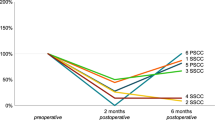Abstract
Superior semicircular canal dehiscence syndrome (SCDS) is a clinical disorder that is characterized by vertigo and oscillopsia induced by loud sounds. Transient evoked otoacoustic emissions (TEOAEs) allow to noninvasively check the integrity of the cochlea. The present study aimed at identifying cochlear stress as the result of micro alterations of the cochlear functionality due to anatomic anomaly. 11 SCDS and 10 normal individuals as control group were submitted to history taking, otological examination, basic audiologic evaluation and TEOAEs analysis using the standard wideband protocol and moving time window analysis. Although TEOAEs test results showed no statistically significant difference using the standard protocol, off-line analysis of the waveforms’ “effective duration” was statistically significantly shortened (p < 0.0001) when compared to normal ears. In conclusion, dehiscence of bone overlying the superior canal has been shown to have effects on inner ear function in terms of a third mobile window theory, thus altering pressure across cochlear partition with decrease in inner ear impedance.



Similar content being viewed by others
References
Minor LB, Solomon D, Zinreich JS et al (1998) Sound- and/or pressure induced vertigo due to bone dehiscence of the superior semicircular canal. Arch Otolaryngol Head Neck Surg 124:249–258
Minor LB (2005) Clinical manifestations of superior semicircular canal dehiscence. Laryngoscope 115:1717–1727
Kemp DT (1986) Otoacoustic emissions, travelling waves and cochlear mechanisms. Hear Res 22:95–104
Zorowka PG (1993) Otoacoustic emissions: a new method to diagnose hearing impairment in children. Eur J Pediatr 152(8):626–634 (review)
Pytel J, Büki B (1995) Moving time window analysis of transiently evoked otoacoustic emissions. Clin Otolaryngol Allied Sci 20(5):439–442
Lonsbury-Martin B, Whitehead M, Martin G (1991) Clinical applications of otoacoustic emissions. J Speech Hear Res 34:964–981
Tsunoda A, Terasaki O (2002) Dehiscence of the bony roof of the superior semicircular canal in the middle cranial fossa. J Laryngol Otol 116(7):514–518
Minor LB, Carey JP, Cremer PD et al (2003) Dehiscence of bone overlying the superior canal as a cause of apparent conductive hearing loss. Otol Neurotol 24:270–278
Mikulec AA, McKenna MJ, Ramsay MJ et al (2004) Superior semicircular canal dehiscence presenting as conductive hearing loss without vertigo. Otol Neurotol 25:121–129
Hamernik RP, Patterson JH, Turrentine GA, Ahroon WA (1989) The quantitative relation between sensory cell loss and hearing thresholds. Hear Res 38:199–211
Avan P, Bonfils P, Loth D, Narcy Ph, Trotoux J (1991) Quantitative assessment of human cochlear function by evoked otoacoustic emissions. Hear Res 52:99–112
Tavartkiladze GA, Frolenkov GI, Kruglov AV (1991) On the site of the otoacoustic emission generation. In: XII IERASG symposium abstracts, pp 58
Songer JE, Rosowski JJ (2007) A mechano-acoustic model of the effect of superior canal dehiscence on hearing in chinchilla. J Acoust Soc Am 122(2):943–951
Jedrzejczak WW, Smurzynski J, Blinowska (2008) Origin of suppression of otoacoustic emissions evoked by two-tone bursts. Hear Res 235(1–2):80–89
Conflict of interest statement
None.
Author information
Authors and Affiliations
Corresponding author
Rights and permissions
About this article
Cite this article
Thabet, E.M. Transient evoked otoacoustic emissions in superior canal dehiscence syndrome. Eur Arch Otorhinolaryngol 268, 137–141 (2011). https://doi.org/10.1007/s00405-010-1313-0
Received:
Accepted:
Published:
Issue Date:
DOI: https://doi.org/10.1007/s00405-010-1313-0




